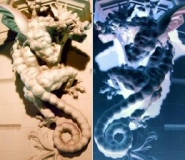Conveners
Parallel Session A. CP violation in the SM and beyond-I
- David WARK (Imperial College)
Debabrata Mohapatra
(Virginia Tech.)
11/12/2008, 14:30
CP Violation: CKM and Beyond
Rare decays, i.e. decays that are expected to have very small
branching fractions, are sensitive to new physics beyond the Standard
Model. The large samples of BB-bar pairs accumulated at the B
factories provide good opportunities to measure such decay modes. We
present a review of recent measurements including hadronic-
electroweak-penguin decays, as well as leptonic decays.
Roberto Versaci
(INFN)
11/12/2008, 14:55
CP Violation: CKM and Beyond
The KLOE experiment has concluded its data taking in March 2006, having
acquired an integrated luminosity of 2.5 fb-1 of e+e- collisions at the
center of mass energy around the phi(1020) resonance. The complete data
set includes a sample of 100 million eta's produced through the radiative
decay phi --> eta gamma and tagged by means of the monochromatic recoil
photon.
This huge amount...
Patrizia De Simone
(Laboratori Nazionali di Frascati (LNF))
11/12/2008, 15:20
CP Violation: CKM and Beyond
The KLOE experiment has provided precise measurements
of the branching ratio of the main neutral and charged kaon
decay modes, of the $K_L$ and the $K^{\pm}$ lifetimes,
and of the $K_L$ vector and scalar form factors.
We present a description of the above measurements and an
overall fit of all our data, with particular attention to correlations.
These data provide the basis for the...
Andrea Romanino
(SISSA/ISAS)
11/12/2008, 15:45
Supersymmetry
We reconsider the mass insertion approximation in the limit in which the sfermions are highly non-degenerate. We show that the correlation between the supersymmetric contributions to Delta F = 1 and Delta F = 2 observables strongly depends on the sfermion spectrum. In particular, we show that larger contributions to the phase of the Bs mixing amplitude are allowed in the non-degenerate case.
Dr
Sergey Sukhoruchkin
(Petersburg Nuclear Physics Institute)
11/12/2008, 16:10
The radiative correction (of the type g/2pi) is one of the commonly used methods of a comparison of the effects
with very different scales [1]. For example, Bernstein marked the closeness of the QED correction (alpha/pi)
to the parameter of CP-nonconservation in kaon decay [2]. There is an exact coincidence between QED
radiative correction alpha/2pi=1.159 10-3 with the ratio between...
